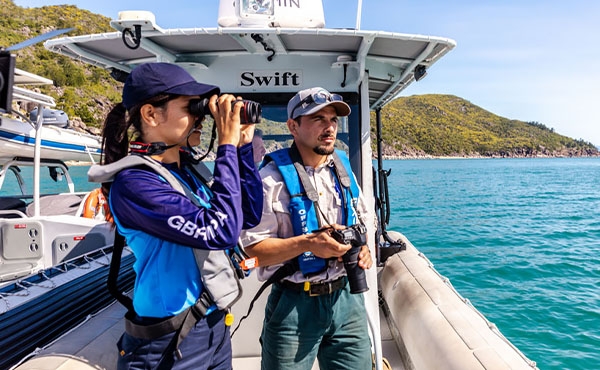Biodiversity is a critical component of the Reef’s outstanding universal value and natural heritage value. Protection of biodiversity values is at the centre of planning and management actions undertaken by managers within the Region.
Protection of biodiversity values is at the centre of planning and management actions
The Reef continues to be exposed to cumulative stressors and consequential impacts. Over the reporting period, the Reef experienced two mass coral bleaching events (2020 and 2022), and one severe cyclone (cyclone Trevor in March 2019). The cumulative impact of coral bleaching events, severe cyclones, poor water quality, crown-of-thorns starfish outbreaks and other stressors, such as unsustainable fishing practices (for example, gill nets), marine debris and changes to coastal ecosystems are not well understood, although descriptive qualitative models and spatial mapping tools are starting to address these gaps.1697
The planning and governance systems for the Reef are complex, span terrestrial and marine environments, engage diverse stakeholder groups, and are based on coordinated planning and decision-making processes. Marine spatial planning for the Reef implements ecosystem-based management, focused on integrated, multi-objective marine plans. These incorporate zoning, enable traditional use of marine resources, support local economies, address impacts, support research and more. Terrestrial spatial land use planning in the regional context focuses on catchment-based planning for natural resource management and traditional land use planning at the local government level. There have been challenges in integration and effective implementation, resourcing and monitoring.
The Intergovernmental Agreement for the Reef sets a framework for joint coordination of planning and management across jurisdictions and incorporates complementary zoning, joint permitting, plans of management, joint policy and consistent management of the Reef Joint Field Management Program, fisheries and the Reef 2050 Plan. The Reef 2050 Plan is the overarching plan addressing most of the key elements required for effective management of biodiversity values. However, given cumulative impacts of climate change and other stressors, the Reef 2050 Plan and its associated plans and strategies lack clear pathways to mitigate significant negative impacts from climate change.1097
The Zoning Plan primarily aims to protect biodiversity. It provides spatial control of use as well as, to a lesser extent, access within the Marine Park. For the most part, complementary arrangements are in place in adjacent areas under Queensland jurisdiction. The Zoning Plan relies on effective permitting arrangements and enforcement for successful implementation. Enforcement has improved with the extension of vessel tracking across the commercial fishing fleet, better targeting of compliance actions based on risk assessment that gives priority to impacts on protected species, and enhanced compliance monitoring technology.

Actions that have, or are likely to have, a significant impact on matters of national environmental significance, including the Marine Park and the World Heritage Area, whether undertaken in or outside the Region, are regulated under the EPBC Act. The 2020 independent review of the EPBC Act notes that compliance and enforcement of provisions under the EPBC Act approvals (that are made outside of the Marine Park) are ineffective, with significant impacts on the ability to protect biodiversity values. This may include illegal discharge or inappropriate management of coastal development activities. In general, for activities that require a Marine Parks permit, there are extensive compliance and enforcement programs under the Marine Park Act, Fisheries Act and other legislation.
Relationships are strongest between the Reef Authority and the Australian and Queensland governments. Engagement in relation to biodiversity values often involves stakeholders being informed and consulted rather than empowered to fully engage in decision-making. Greater efforts have been made to engage with Traditional Owners since 2019. There are strong and growing connections between decision-making, research and a range of actors, such as through the Reef 2050 Integrated Monitoring and Reporting Program (RIMReP). However, a broader range of stakeholders could be engaged in decision-making, including farmers, fishers, mining companies, energy providers, property developers and individual citizens.2001
More than 90 monitoring programs for biodiversity values operate within the Region. Current monitoring represents about 40 per cent of the environmental regimes of the Reef 1697 and confidence around condition status is limited for some species and ecosystem processes because of a lack of long-term data over a broad area.2002 Significant improvements have been made in the design and updating of monitoring programs through the Reef 2050 Integrated Monitoring and Reporting Program. The focus has been on addressing priority monitoring gaps, Reef-wide decision support-systems and developing new strategies to access information. There are also improvements in information sharing, for example the Reef Knowledge System provides accessible up-to-date information about the Reef to guide management decisions.
Since 2019, there has been significant investment in Reef programs, updating of relevant plans, expanded monitoring efforts, prioritisation of research and improvements to governance arrangements, such as expansion of Traditional Use of Marine Resource Agreements. Partnerships are expanding, leading to significant improvements in engagement with Traditional Owners. This includes the incorporation of Indigenous knowledges and moves towards co-management through Traditional Use of Marine Resource Agreements and other mechanisms.
While important advances have been made since 2019, the challenges facing the Reef are increasing in scale and complexity. Despite a suite of planning documents, significant inputs and a comprehensive range of outputs, outcomes for biodiversity are assessed as partially effective and in decline. The downward trend in outcomes relates to poor protection of values, poor reduction of the major risks and threats to the Reef and poor environmental and economic sustainability in relation to use of the Reef. Widespread emission of greenhouse gases continues to impact the Reef, although recent improved emissions reductions targets (national and state levels) are a positive step forward. It is unclear whether the current plans, actions and investments will be sufficient to protect biodiversity in the face of significant cumulative threats, primarily related to the impacts of climate change.
The challenges facing the Reef are increasing in scale and complexity
The stressors on the Reef indicate that the current governance system may be inadequate to improve biodiversity outcomes.2001,2003,2004,2005 The system ‘is not built with the agility required to adapt to rapidly evolving climate impacts’,2006 reflecting a need for more substantial institutional redesign or rethinking of principles and values underpinning governance goals.2007 Work programs supporting the Reef (at least 58) 2008 are not currently considered to be at the required scale, coherence or responsiveness to the emerging threats to biodiversity. The Reef 2050 Integrated Monitoring and Reporting Program identified Reef governance as a critical monitoring gap 2009 and a governance monitoring program is under development to identify indicators to assess governance effectiveness in relation to Reef 2050 Plan objectives.2
Key challenges remain, including: identifying realistic values and outcomes for the Reef under a climate-changed future and the likelihood of ongoing ecosystem function decline; managing for coral resilience and understanding how multiple stressors affect different demographic processes and reef recovery; engaging in co-management and co-governance arrangements with Traditional Owners to manage biodiversity; and enhancing communication among all stakeholders, including researchers, farmers and the community.


